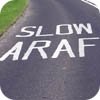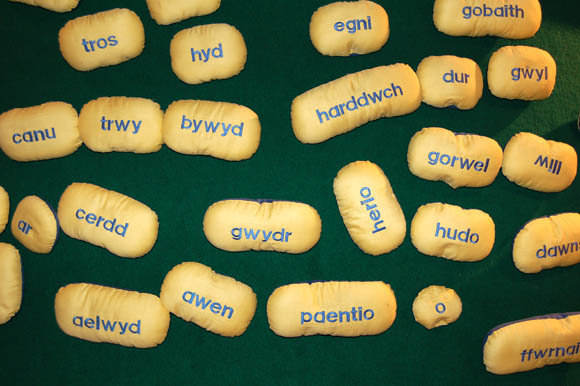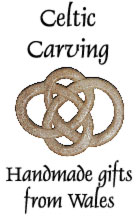
| Cymraeg - The Welsh Language
Welsh (Cymraeg or y Gymraeg is a member of the Brythonic branch of Celtic spoken natively in Wales (Cymru), England by some along the Welsh border, and in the Chubut Valley, a Welsh immigrant colony in the Patagonia region of Argentina.
There are also speakers of Welsh throughout the world, most notably in the rest of Great Britain, the United States and Australia.
The 2001 census gives a figure of 20.5% of the population of Wales as Welsh speakers (up from 18.5% in 1991), out of a population of about 3 million; however, the same census shows that 25% of residents were born outside Wales. The number of Welsh speakers throughout the rest of Britain is uncertain, but numbers are higher in the main cities and there are speakers along England's border with Wales. In 1993, S4C, the Welsh-language TV channel published the results of a survey into the numbers of people speaking/understanding Welsh, and this estimated that there were some 133,000 Welsh-speakers living in England, about 50,000 of them in the Greater London area.
Even among the Welsh-speakers, few residents of Wales are monolingual in Welsh. However, a large number of Welsh speakers are more comfortable expressing themselves in Welsh than in English. A speaker's choice of language can vary according to the subject domain (known in linguistics as code-switching).
Although Welsh is a minority language, and thus threatened by the dominance of English, support for the language grew during the second half of the 20th century, along with the rise of nationalist political organisations such as the political party Plaid Cymru and Cymdeithas yr Iaith Gymraeg (the Welsh Language Society).
Welsh as a first language is largely concentrated in the less urban north and west of Wales, principally Gwynedd, Denbighshire, Anglesey (Ynys M�n), Carmarthenshire, North Pembrokeshire, Ceredigion, and parts of western Glamorgan, although first-language and other fluent speakers can be found throughout Wales.
Welsh is very much a living language. It is used in conversation every day by thousands and seen in Wales everywhere. The Welsh Language Act 1993 and the Government of Wales Act 1998 provide that the Welsh and English languages should be treated on a basis of equality. Public bodies are required to prepare and implement a Welsh Language Scheme. Thus local councils and the Welsh Assembly use Welsh as an official language, issuing official literature and publicity in Welsh versions (e.g. letters to parents from schools, library information, and council information) and all road signs in Wales should be in English and Welsh, including the Welsh versions of place names. The teaching of Welsh is now compulsory in all schools in Wales up to age 16, and this has had a major effect in stabilising and to some extent reversing the decline in the language. It means, for example, that even the children of English monoglot migrants to Wales grow up with a knowledge of the language. However, in everyday life the language is virtually never used in the main population centres in the south of Wales.
Welsh also has a substantial presence on the Internet, but this is strongly biased towards public bodies: the ratio of search engine hit frequencies for Welsh words to their English equivalents tends to be about 0.1% for formal terms such as addysg (education), cymdeithas (society) or llywodraeth (government), but only about 0.01% for everyday terms such as buwch (cow), eirlaw (sleet) or cyllell (knife).
History
Like most languages, there are identifiable periods within the history of Welsh, although the boundaries between these are often indistinct.
The earliest extant sources of a language identifiable as Welsh go back to about the 6th century, and the language of this period is known as Early Welsh. Very little of this language remains. The next main period, somewhat better attested, is Old Welsh (Hen Gymraeg) (9th to 11th centuries); poetry from both Wales and Scotland has been preserved in this form of the language. As Germanic and Gaelic colonisation of Great Britain proceeded, the Brythonic speakers in Wales were split off from those in northern England, speaking Cumbrian, and those in the south-west, speaking what would become Cornish, and so the languages diverged.
Middle Welsh (or Cymraeg Canol) is the label attached to the Welsh of the 12th to 14th centuries, of which much more remains than for any earlier period. This is the language of nearly all surviving early manuscripts of the Mabinogion, although the tales themselves are certainly much older. It is also the language of the existing Welsh law manuscripts. Middle Welsh is reasonably intelligible, albeit with some work, to a modern-day Welsh speaker.
Modern Welsh can be divided into two periods. The first, Early Modern Welsh ran from the 14th century to roughly the end of the 16th century and was the language used by Dafydd ap Gwilym.
Late Modern Welsh began with the publication of William Morgan's translation of the Bible in 1588. Like its English counterpart, the King James Version, this proved to have a strong stabilising effect on the language, and indeed the language today still bears the same Late Modern label as Morgan's language. Of course, many minor changes have occurred since then.
The language enjoyed a further boost in the 19th century, with the publication of some of the first complete and concise Welsh dictionaries. Early work by Welsh lexicographic pioneers such as Daniel Silvan Evans ensured that the language was documented as accurately as possible, and modern dictionaries such as the Geiriadur Prifysgol Cymru (the University of Wales Dictionary), are direct descendants of these dictionaries.
However, the influx of English workers during the Industrial Revolution in Wales from about 1800 led to a substantial dilution of the Welsh-speaking population of Wales. English migrants seldom learnt Welsh and their Welsh colleagues tended to speak English in mixed Welsh�English contexts, and bilingualism became almost universal. The legal status of Welsh was inferior to that of English, and so English gradually came to prevail, except in the most rural areas, particularly in north west and mid Wales. An important exception, however, was in the non-conformist churches, which were strongly associated with the Welsh language.
By the twentieth century, the numbers of Welsh speakers were shrinking at a rate which suggested that it would be extinct within a few generations. The 10-yearly census first started to ask language questions in 1891, by which time 54% of the population still spoke Welsh. The percentage fell with every subsequent census, until reaching an all-time low in 1981 (19%). In 1991 the position was stable (19% as in 1981) and in the most recent census, 2001, it has risen to 21% able to speak Welsh. The 2001 census also recorded that 20% could read Welsh, 18% could write Welsh, and 24% could understand Welsh. Furthermore, the highest proportion of Welsh speakers was among young people, which bodes well for the future of Welsh. In 2001, 39% of children aged 10 to 15 were able to speak, read and write Welsh (many of them having learnt it at school), compared with 25% of 16 to 19 year olds.
It seems that the rise of Welsh nationalism rallied supporters of the language, and the establishment of Welsh television and radio found a mass audience which was encouraged in the retention of its Welsh. Perhaps most important of all, at the end of the twentieth century it became compulsory for all school children to learn Welsh up to age 16, and this both reinforced the language in Welsh-speaking areas and reintroduced at least an elementary knowledge of it in areas which had become more or less wholly Anglophone. The decline in the percentage of people in Wales who can speak Welsh has now been halted, and there are even signs of a modest recovery. However, although Welsh is the daily language in many parts of Wales, English is almost universally understood.
Dialects
Like any natural language, Welsh has a number of different dialects.
These are very evident in the spoken, and to a lesser extent the written, language. A convenient, if slightly simplistic, classification is into North Walian and South Walian forms (or "Gog" and "Hwntw" based on the word for North, gogledd, and the South Walian word for "them over there"). The differences between dialects encompass vocabulary, pronunciation and grammar, although particularly in the last regard the differences are in fact relatively minor. Much more fine-grained classifications exist beyond north and south: Beth Thomas and Peter Wynn Thomas's book on the dialects of Welsh refers to the earlier Linguistic Geography of Wales (Alan R Thomas, 1973) as describing six different regions which could be identified as having words specific to those regions; the cassette accompanying their book includes recordings of fourteen different speakers demonstrating aspects of different dialects.
Another dialect is Patagonian Welsh, which has developed since the start of the Welsh settlement in Argentina in 1865; it includes Spanish loanwords and terms for local features.
An example of the difference between North and South Walian usage would be the question "Do you want a cup of tea?". In the North this would typically be "Dach chi isio panad?", while in the South the question "Dych chi'n moyn dishgled?" would be more likely. An example of a pronunciation difference between Northern and Southern Welsh is the tendency of Southern dialects to "lisp" the letter "s".
In fact, the difference between dialects of modern spoken Welsh pale into insignificance compared to the difference between the spoken and literary languages. The latter is significantly more formal and is the language of Welsh translations of the Bible, amongst other things (although the Beibl Cymraeg Newydd � New Welsh Bible � is significantly less formal than the traditional 1588 Bible). Gareth King, author of a Welsh grammar, goes so far as to observe that "The difference between these two is much greater than between the virtually identical colloquial and literary forms of English � so great, in fact, that there are good grounds for regarding them as separate languages", and comments that whilst colloquial Welsh is a mother tongue requiring no special learning to acquire, literary Welsh is the mother tongue of no-one, and must be taught to people.
Although the question "do you want a cup of tea?" is not likely to occur in literary Welsh usage, if it did it would be along the lines of "a oes arnoch eisiau cwpanaid o de?".
Amongst the characteristics of the literary, as against the spoken, language are a higher dependence on inflected verb forms, a shift in the usage of some of the tenses, a reduction in the explicit use of pronouns (since the information is usually conveyed in the verb/preposition inflections) and a greatly reduced tendency to substitute English loan-words for native Welsh words.
[edit]
Welsh In Education
The decade around 1840 was a period of great social upheaval in Wales, manifested in the Chartist movement, which culminated in 20,000 people marching on Newport in 1839 resulting in a riot when 20 people were killed by soldiers defending the Westgate Hotel, and the Rebecca Riots when tollbooths on turnpikes were systematically destroyed. This unrest brought the state of education in Wales to the attention of the English establishment, as social reformers of the time considered education as a means of dealing with social ills, The Times newspaper being prominent among those who considered that the lack of education of the Welsh people was the root cause of most of the problems, although the population was generally literate in Welsh because of the activities of Sunday Schools and the need to read the Bible. In July 1846, three commissioners, R. R. W. Lingen, Jellynger C. Symons and H. R. Vaughan Johnson, were appointed to inquire into the state of education in Wales; the Commissioners were all Anglicans, and hence unsympathetic to the Non-conformist majority in Wales, and were monoglot English-speakers.
The Commissioners presented their report to the Government on 1 July 1847 in three large blue-bound volumes. This report quickly became known as Brad y Llyfrau Gleision (The Treachery of the Blue Books) as, apart from documenting the state of education in Wales, the Commissioners were also free with their comments disparaging the language, Non-conformity, and the morals of the Welsh people in general. An immediate effect of the report was for a belief to take root in the minds of ordinary people that the only way for Welsh people to get on in the world was through the medium of English, and an inferiority complex developed about the Welsh language whose effects have not yet been completely eradicated. The historian Professor Kenneth O. Morgan referred to the significance of the report and its consequences as "the Glencoe and the Amritsar of Welsh history".
In the later 19th century virtually all teaching in the schools of Wales was in English, even in areas where the pupils barely understood English. Some schools used the Welsh Not, a piece of wood, often bearing the letters "WN", which was hung around the neck of any pupil caught speaking Welsh. The pupil could pass it on to any schoolmate heard speaking Welsh, with the pupil wearing it at the end of the day being given a beating. Towards the beginning of the 20th century this policy slowly began to change, partly owing to the efforts of Owen Morgan Edwards when he became chief inspector of schools for Wales in 1907.
The Aberystwyth Welsh School (Ysgol Gymraeg Aberystwyth) was founded in 1939 by Sir Ifan ap Owen Edwards, the son of O.M. Edwards as the first Welsh Primary School. The headteacher was Norah Isaac. Ysgol Gymraeg is still a very successful school and now there are Welsh language Primary Schools all over the country.
Welsh is now widely used in education. All Welsh universities teach some courses in Welsh (most notably the University of Wales, Bangor and the University of Wales, Aberystwyth) but are primarily English language.
Under the National Curriculum, school children in Wales must study Welsh up to the age of 16. According to the Welsh Language Board [5], over a quarter of children in Wales attend schools which teach predominantly through the medium of Welsh. The remainder study Welsh as a second language in English-medium schools. Specialist teachers of Welsh called Athrawon Bro support the teaching of Welsh in the National Curriculum.
Welsh In The Economy
The economic benefits of the Welsh language are also increasingly being recognised, both by employers and by employees.
Throughout Wales more and more employers � in the public, private and voluntary sectors � in response to the growing expectations of their customers, are becoming aware of the benefits of using the language, such as: - improving the quality of customer service
- attracting new customers
- increasing customer loyalty
- harnessing goodwill at relatively low cost
- gaining a marketing edge over competitors
- enhancing public relations efforts
With organisations in all sectors offering more and more bilingual services, they obviously need people with bilingual skills to deliver them.
And, in the workplace, the ability to speak or write in Welsh and in English is a valuable skill, just like computer or financial skills. The number of people with bilingual skills needed will of course vary from one organisation to the next, depending on its location what type of service it provides and how it deals with its customers.
The reality is that over the next decade in Wales, this situation will continue to develop, in response to customers' wishes and expectations. There will be jobs at all levels for which an ability to work bilingually will be desirable, if not essential.
This is one of the great factors which continues to drive the demand for Welsh-medium education and vocational training, as young people and their parents recognise the economic value of the Welsh language.
Welsh In Warfare
Secure communications are often difficult to achieve in wartime. Cryptography can be used to protect messages, but this can be a time-consuming process and may not be feasible if the message is urgent. Instead, Navajo code talkers were used by the Americans during World War II. It has been rumoured that British forces used Welsh in a similar manner.
More recently, Welsh regiments serving in Bosnia used Welsh for emergency communications that needed to be secure.
|








Jen